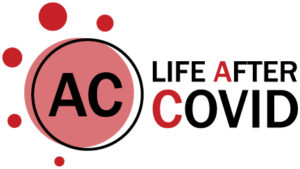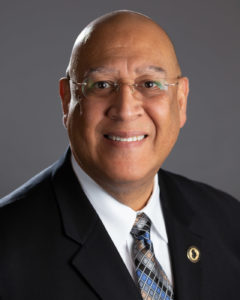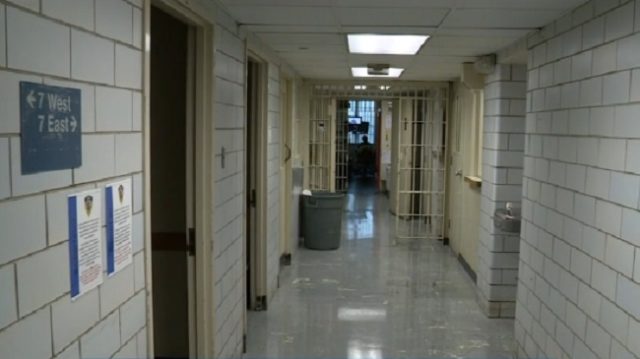
This piece is part of a collaboration that includes the Institute for Nonprofit News, The Beacon/KCUR 89.3; Bridge Michigan/Side Effects Public Media; Cicero Independiente/South Side Weekly; Detour Detroit/Planet Detroit/Tostada Magazine; Evanston RoundTable/Growing Community Media; Madison365/Wausau Pilot & Review; and MinnPost/Sahan Journal. The project was made possible by a grant from the Robert Wood Johnson Foundation with additional support from INN’s Amplify News Project and the Solutions Journalism Network.
In the five years preceding the COVID-19 pandemic, the number of people incarcerated in Wisconsin took a steady climb, resulting in overcrowded jails and strained county budgets.
Jail officials say the pandemic distilled to its essence how they thought about the use of jail. As they feared, crowded jails and prisons quickly became deadly. From March 2020 through June 2021, at least 398,627 people in prison tested positive for the illness, according to The Marshall Project. The actual number is likely much higher.
Though corrections officials have just limited control over the length of time people spend in their custody, they can use their authority to use less restrictive means of confinement. Even before the pandemic hit, officials throughout the state were searching for answers. Those efforts took on new urgency as the coronavirus brought on unique challenges that threatened the health of inmates, staff and the community at large.
The jail population in Marathon County ballooned to 430 in 2017, resulting in millions of taxpayer dollars spent on housing inmates at other jails. At the time, Marathon County Jail Administrator Sandra LaDu estimated the total cost to taxpayers of transporting and housing inmates outside the county topped $1.7 million annually. That led the National Institute of Corrections to recommend the Marathon County Sheriff’s Department implement new alternatives to incarceration to help decrease the population.
With 89 percent of the county’s inmates locked up for non-violent offenses, NCI staff in 2017 recommended the county implement pretrial release programs, drug and OWI courts, as well as options for domestic violence compliance.
Consequently, a diversion program launched in late 2017 for people charged with operating after revocation, one of the most commonly-charged offenses in Marathon County. The diversion program kept people out of jail by helping them regain their driving privileges with the help of a case manager, rather than landing on a prosecutor’s desk. In early 2018, the county launched a drug court program, which is sentenced as a condition of probation instead of a prison term. Prosecutors also began to increase their reliance on diversion programs for first-time offenders that, on any given day, has kept about 500 people out of jail through assessments and case planning.
But those efforts didn’t address the sheer number of people being brought into the jail by police.
By 2019, Marathon County was deep in the throes of evidence-based decision making, an initiative that uses research findings to guide decisions across the justice system. The county was among 25 jurisdictions selected nationwide as a pretrial pilot site to implement EVDM, which aims to improve collaboration and practices in the criminal justice system. Police, prosecutors, mental health providers and judges, along with representatives from probation and parole, participated in the planning process. At its core was a proxy assessment, a tool that gave officers discretion on whether to take a suspect directly to jail, issue a citation or use a summons for a later court appearance.
Under the proxy system, officers continued arresting suspects in domestic-related violations, violent crimes and most felony violations. But not everyone was immediately taken to jail to be held until a court appearance. Suspects with a valid Wisconsin driver’s license or who could show they had sufficient ties to the community could be released along with those considered “low risk.” But Marathon County Chief Deputy Chad Billeb said the proxy tool was just that – a tool to help police decide how to handle a criminal matter. Other factors still played a role.
“Basically, we went back to using common sense,” Billeb said. “Have I exhausted all their options? Yes? Then they go to jail. If there are other options, we want to use those first.”
When the coronavirus pandemic hit, the need to assess whether arrests required immediate booking became all the more relevant, as corrections staff looked for ways to depopulate crowded jails and make them safer. In Marathon County, deputies and officers on patrol stopped arresting people on low-level warrants, a policy that didn’t sit well with some working the beat. Billeb said that while some officers resisted the changes, reducing the number of people brought directly to jail made sense then and will continue to make sense now.
“We shouldn’t be arresting someone because it’s convenient,” Billeb said. “Is a victim at immediate risk? Absolutely, we should arrest someone. Is someone out on probation and they miss a call with their supervising agent? Guess what. We’re not bringing them in. That now falls to probation for follow-up.”
Marathon County Deputy Jail Administrator Paul Mergandahl, who spent decades in the criminal justice system and will retire this year, said allowing officers more latitude in who they bring to jail in the first place is a tool that can be transformational.
“If all you have is a hammer, everything looks like a nail,” Mergandahl said.

Dane County Sheriff Kalvin Barrett agrees.
“I believe discretion is a big part of what we have, and it’s the biggest tool that we have as peace officers,” he said. “I believe that our abilities to find alternative ways of custodial arrests is monumental in regards to how we can really help reduce our jail population.”
Barrett took over in early May for retiring Sheriff Dave Mahoney, and has already announced that he’ll run for a full term in 2022. He’s made reducing arrests and reducing the jail population central to his platform.
“It’s important to me because I understand the effects of incarceration. I understand how that affects employment, how that infects the mental health of someone, how that affects family relationships,” said Barrett, the county’s first Black sheriff. “All of the effects of incarceration really play a significant role in our overall community safety and our society’s well being. Every day that someone spends incarcerated, they could be out and about getting a job, working, being with their families and contributing to society. So that’s why it was very important to me to ensure that we are not increasing our population unnecessarily.”
Barrett said he’d like to see local police practice more restraint in arresting people when there isn’t an immediate threat to the community, and more nuance at the state level as well, where probation and parole officers can send people to county jails for technical violations of their parole and probation conditions.
“We don’t have much control over what probation and parole does, but it would be great to see a continued re-evaluation of practices so that we aren’t needlessly incarcerating individuals for non-violent crimes,” he said.
Back in Marathon County, the proxy system was ultimately discontinued after officials determined the matrix being used was too complex. The policy of “jail as a last resort” has continued, though, and Billeb expects it to last. Now, he said, the stabilized jail numbers are being used as a check valve, knowing that judges will be overwhelmed if too many people are picked up for minor offenses and the jails fill up once again.
“At the end of the day, we’re not the punishers,” Billeb said, of police and deputies. “Whether we bring someone to jail is a decision that should be based on training, guidance and leadership.”
Some inmates who are serving sentences are now serving them in different ways. In response to the pandemic, Marathon County also eliminated its Huber program, transitioning sentenced inmates who are allowed work release to electronic monitoring. Wisconsin’s Huber law, commonly referred to as “work release,” allows county jail inmates to leave the jail to work, seek employment, attend school or medical treatment, conduct family child care or other specific purposes. Inmates granted Huber privileges are housed in a specific block of the jail.
Those inmates are now serving their sentences at home, while they care for their children and keep their employment. That frees up jail beds and saves taxpayer money, Mergandahl said. Inmates on the EMP program pay the county $40 the first day and $18 each day thereafter, though some are eligible for reduced or eliminated costs based on financial eligibility requirements. A jail stay, by contrast, costs taxpayers roughly $51 per day for each day spent behind bars. The overall savings to taxpayers is not yet clear, as budget figures have not been finalized.
From a public safety standpoint, Deputy Jail Administrator Mergandahl said the community is “almost or just as safe” as before the changes were made, since inmates in the EMP program are not violent offenders and are selected through an objective classification process that looks at potential threats to the community and the likelihood to reoffend.
LaDu said Marathon County has been relying heavily on electronic monitoring since May 2020.
“After seeing the number of persons who are being sentenced who are not [either] going to prison or eligible for electronic monitoring, it does not make sense for us to use a block of eight plus beds for those one or two people, requiring us to house more people out of county,” LaDu said in February, when the county officially began a six-month Huber elimination trial program.
Marathon County is not alone. Worldwide, there are about 25% to 30% more prisoners wearing electronic bracelets now than just a few months ago, corrections officials say. Criminal justice experts are eyeing the trend closely, openly wondering if this could indeed be a test run for a longer-term shift in sentencing.
In Marathon County, there are some exceptions to the EMP program. People who are sentenced on domestic violence-related charges won’t be able to live with their victims. Instead, they’ll need to secure a suitable living environment before being granted a monitor. Further, people serving sentences shorter than seven days will be required to serve their time.
“I am certain there will be a number of questions, but please realize we have essentially been doing this since Summer 2020,” LaDu said, in a memo to attorneys and jail staff that she shared with Wausau Pilot & Review. “It is only now that we are making the trial official to determine why this is, or is not a good plan moving forward.”

At the state level, State Department of Corrections Secretary Kevin Carr said discretion in arrests and sentencing can reduce the number of people coming in, programming can also increase the number of people getting out and freeing up beds.
He cited the Earned Release Program as an example. The program allows certain inmates to shorten their sentences.
“The Earned Release Program allows folks who are within a certain period of time of release, who are in custody for substance use disorder charges or related charges, for them to go through a program. And if they successfully complete the program, be released early,” he said. “Right now, the criteria has been expanded under our administration so that we widened the pool to make more people eligible to participate in that program so that, hopefully, we will end up releasing more people, thus reducing our population.”
But that kind of programming requires funding — and legislative approval. The Republican-controlled legislature removed expansion of the ERP in Governor Tony Evers’ proposed budget.
“The legislature, by not expanding the early release program and not supporting or agreeing to any of the governor’s criminal justice reforms that he put in the budget, they’re not doing anything to help us reduce our prison population at this time,” Carr said.
He said it shouldn’t be a partisan issue, but rather an issue of results.
“There are conservative states all around this country that have engaged in comprehensive criminal justice reform that has resulted in meaningful reductions in the prison population,” Carr said. “And we just can’t get on board with that here. There’s no legislative will to do it … And it would save the taxpayers money, which I thought would be a motivator. I don’t care what your motivation is for doing it. It’s just the right thing to do. Because if it helps people change their lives and results in more productive persons being released from our system, and it lowers costs, and it doesn’t raise crime levels, I don’t know what not to like about that.”
Tomorrow: Advocates react to efforts to reduce the corrections system’s population.




























